Search Results
Normal Yellow line resumes following derailment repairs; investigation update
Basic service information for BART riders is provided first and then a rolling update of what happened is provided for the media and public.
Tuesday, January 2 at 4:45am Update: BART will provide normal Yellow line service following overnight repairs and inspections between Lafayette and Orinda stations. The bus bridge has been cancelled.
Monday, January 1 at 10pm Update: The bus bridge will remain in effect through the end of service tonight (1/1/24). Crews will work to make repairs and inspect the tracks this evening and overnight. We hope for normal train service between Walnut Creek and Rockridge tomorrow (1/2/24).
Rolling Updates:
Wednesday, January 3, 2024 Major Update at 2pm:
BART provides update on Monday’s partial derailment on the Yellow line
While the investigation of the derailment continues, BART is providing an update on what occurred and next steps.
Condition of track equipment
That section of track where the derailment occurred, including the interlocking, was recently replaced and was in good operating order. BART’s train control system is being modernized as part of implementing Communications Based Train Control, a major rebuilding project underway.
Timeline of what happened
At 8:45am on Monday, January 1, 2024, the computer system that monitors and manages BART tracks experienced a localized loss in communication with a field device specific to an area near Orinda Station, including the track interlocking located between Orinda and Lafayette stations. When this occurs, the Operations Control Center does not receive a status indication of route alignments in the area and track positions cannot be controlled remotely. The computer and communication system fails in a safe mode and there are procedures in place to continue to provide train service while crews troubleshoot the loss of computer communication. The system had been operating at the start of revenue service and one train had already travelled eastbound through the area.
At 8:50am the Operations Control Center instructed the train operator of an approaching 8-car Antioch bound train to manually align the route at the interlocking. The route was to be straight through. The train operator left the cab to align the track route. PA announcements were made to riders on board about the delay. The train operator confirmed with the control center they had set the track for a straight through alignment. The control center instructed them to drive the train in manual mode through the area.
Once moving, the train operator reported to the control center the train was crossing over to the opposite track, which was not the correct alignment. In response the control center held all trains in the area and instructed the train operator to move from the Antioch end of the train to the SFO end of the train and to move the train in the SFO direction to clear the interlocking area of the track and correctly align the route for straight through movement. The train operator walked to the other end of the train and moved it in manual mode in the SFO direction. Two cars derailed under slow speed causing electrical arcing, smoke, and flames. Some riders immediately started to self-evacuate by using the emergency door release.
At 9:05am the train operator reported to the control center they believed the train had derailed. The train operator then began to sweep the train, walking through each car to tell people to evacuate. The operator reported the smoke and flames to the control center and advised that people had already started evacuating.
Orinda Police were first to arrive on scene and helped evacuate all riders safely and Orinda Fire Department extinguished the flames.
By 9:23am, the control center was told all riders on board, estimated to be about 100-150 people, had been safely evacuated from the train.
Next steps
The investigation into the derailment continues. BART has 60 calendar days from the date of the incident to provide a report to the California Public Utilities Commission (CPUC). Until the CPUC accepts and closes the report, the incident is considered "under investigation", until such time, the report is unavailable to the public.
4:45am Update: Normal Yellow line service will run today following overnight repairs and safety inspections. The headline for this story has been changed to reflect this update.
A BART spokesperson will be at Orinda Station at 6:00 am.
9:30pm Update:
The incident train is now moving towards the yard. Crews are working on repairs. We will be using our tamper vehicle to surface the track area, pounding down the rocks/ballast. The good news is there was no damage to track switches which would have required more extensive repairs.
The bus bridge will remain in effect through the end of service tonight. Crews will work to make repairs and inspect the tracks this evening and overnight. We hope for full normal service between Walnut Creek and Rockridge tomorrow.
7pm Update:
The crane has successfully re-railed both impacted cars. We will now couple the incident cars with others to tow them out of the way. Track crews have already begun making repairs to damaged sections of the track so we are hopeful to have, at minimum, single tracking train service through the area for morning service. It could be full normal service depending on progress made.
4:40pm Update:
The crane arrived on scene.
4pm Update:
The two lanes on Eastbound Highway 24 are now closed and crane is enroute for placement.
3:15pm Update:
BART is currently working with Caltrans to close two lanes of Eastbound Highway 24 within in the next hour for a large crane that will position the incident BART train back in place. We do not have an ETA on how long it will take but will provide frequent updates on the process.
2pm Update (Latest Write-Up on What Happened):
The partial derailment occurred at an interlocking located between the Orinda and Lafayette BART stations shortly after 9am. Just prior to the derailment, the train operator was instructed by the Operations Control Center to manually align the route at the interlocking because a signaling issue prevented the computer from doing it. This procedure is not uncommon and train operators are trained to manually align routes. The operator then manually moved the train when it derailed. The train was not under automatic train control. The complete details into what happened are under investigation.
The incident train was an 8-car Antioch bound train. Two cars derailed. There was smoke and flames. All riders were safely evacuated. There were no major injuries, though nine people were transported to area hospitals for evaluation. The Orinda Fire Department responded and extinguished the flames.
A large crane will be needed to get the incident train back in place on the tracks. This crane will be positioned on Highway 24 eastbound. Two highway lanes will be closed for this. The train will then be moved to a yard and track inspections and any repairs will need to take place.
The California Public Utilities Commission was notified and their staff were on scene.
The incident train was an 8-car Antioch bound train and it was the first train of the morning to travel in that direction. Two cars derailed. There was smoke and flames. The Orinda Fire Department responded and extinguished the flames. All riders were safely evacuated. There were no major injuries through nine people were transported to area hospitals for evaluation.
12:30pm Update (Bus Bridge Available)
A bus bridge provided by AC Transit and County Connection is now in place providing full bus service between Rockridge and Walnut Creek in both directions. Buses will make all station stops.
Yellow line riders should expect major delays all day. Trains are turning around at Rockridge and Walnut Creek where riders will need to board a bus. No other BART lines are impacted.
Noon update (injury update and correction):
Nine people were transported to medical facilities for evaluation following this incident. Based on the initial report from first responders there were no major injuries. BART Police will be interviewing all people who were transported for evaluation. A correction has been made below.
11:15am update: BART has powered off the rails between Rockridge and Walnut Creek stations. All passengers that were on board trains in that section of track have been off-boarded. BART is working with partner bus agencies to establish a bus bridge but it is not yet in place.
Only the Yellow line (between Walnut Creek and Rockridge is impacted). All other lines are running.
A BART media spokesperson is at Orinda Station.
BART Service Advisories are available via SMS text, email, at the top of bart.gov, on the BART app, and on X (Twitter) at @SFBARTalert, the main @SFBART account is also providing updates.
The Official BART App offers customized in-app notifications about BART service. Riders can personalize what type of information they get through the app based on when and where they ride BART and what information they care most about.
10:15am Update:
Shortly after 9am on Monday, January 1, 2024, an east bound Yellow line train partially derailed between Orinda and Lafayette stations just outside the Orinda station.
Passengers were safely evacuated from the train and were escorted to Orinda Station by BART personnel. Nine people were transported to medical facilities for evaluation*. Based on the initial reports from first responders there were no major injuries. BART Police will interview all people who were transported for evaluation to get an update.
Two cars were reported to be on fire with smoke and the Orinda Fire Department responded and extinguished the flames.
The Orinda and Lafayette BART stations were closed and we are advising Yellow line riders to seek alternative transportation at this time. There is no train service between Rockridge and Walnut Creek. There is currently no available bus bridge but staff is working to see if partner bus agencies are available.
BART has extra staff and BART Police at Orinda and Lafayette stations to help.
Other BART lines are not impacted.
9:28am Service Advisory posted:
There is a major delay on the Antioch Line in the Antioch and SFO directions due to an equipment problem on a train between Orinda and Lafayette stations. Please seek alternate means of transportation.
9:21am Service Advisory posted:
There is a major delay on the Antioch Line in the Antioch and SFO directions due to an equipment problem on a train.
*An earlier update said there were no reported injuries, however BART has learned from first responders that nine people were transported to medical facilities for evaluation.
Tap and Ride
Board of Directors
Normal service restored on the Green Line following May 20 fire
Update (5/26/25, 8:30am)
As of Sunday, May 25, normal service has been restored on the Green Line. That means BART is now offering service on all five lines. Crews had been working overnight since the Tuesday morning fire at San Leandro Station to replace wayside track equipment so Green Line service could be restored. Trains are running on a Sunday schedule for Memorial Day on all 5 BART lines.
Update (5/22/25, 1:45pm)
Our crews continue to make repairs to the damaged trackside train control equipment from Tuesday's fire. Our current projections for returning Green Line service is Tuesday, May 27, 2025. All 50 stations are open and riders can get to all locations but there is no Green Line service.
There is an investigation into the root cause of the fire. We know there was an electrical fault on our DC power system, from our 1000 volt DC cable that was part of BART's original system (50+ years old) and a fire started. The fire then damaged trackside train control equipment and sections of fiber and our 34.5kV cable.
While faults are not uncommon in the BART system, it is very rare that this fault escalated to this level. Typically electrical faults are isolated by protections such as transfer trips and circuit breakers.
On May 22, 2025, the BART Board of Directors were given updates about this service disruption and well as the one that occurred on May 9, 2025, when a computer network problem prevented BART service from starting in the morning, causing a systemwide outage until 9am.
Update (5/21/25, 8:55am)
Service was restored to all fifty BART stations at the start of revenue service this morning after an early morning fire on Tuesday near San Leandro Station. Trains are again running between Lake Merritt, Berryessa/North San Jose, and Dublin/Pleasanton stations.
All stations are open, and riders can access every part of the system.
Trains will be running at reduced speeds between Bay Fair and Coliseum stations, and there is currently no Green Line service due to fire damage to wayside track equipment. Repairs are expected to take several days.
There is redundant service, meaning riders can get anywhere in the system they want to go, just in some cases, with a transfer. Passengers traveling from Berryessa to San Francisco can take the Orange Line (toward Richmond) and transfer at Bay Fair to a Blue Line train (toward Daly City).
We are running longer trains on the Orange Line to accommodate increased ridership on this line.
Limited BART service was restored earlier Tuesday afternoon around 5:30 p.m., with trains running from Berryessa to Bay Fair and Bay Fair to Dublin/Pleasanton stations.
The fire was related to a power issue and there is an active investigation into exactly what happened.
Update (5/20, 9:46 pm)
Systemwide BART service will be restored Wednesday, May 21 with trains again running between Lake Merritt, Berryessa/North San Jose, and Dublin/Pleasanton stations after an early Tuesday morning fire on the tracks just south of San Leandro Station.
All stations will be open with service to all areas of the system, but trains will be running at reduced speeds between Bay Fair and Coliseum stations.
The fire was reported at 5am on May 20, and service was halted between Berryessa, Dublin/Pleasanton, and Lake Merritt. Stations with no service were closed.
Limited BART service was restored earlier Tuesday afternoon around 5:30 p.m., with trains running from Berryessa to Bay Fair and Bay Fair to Dublin/Pleasanton stations.
The determination to resume service followed repairs, inspections, and testing of the track and various equipment.
The cause of the fire is not yet known.
Update (5/20, 5:23pm): BART service has been partially restored and trains are running from Berryessa to Bay Fair and Bay Fair to Dublin/Pleasanton.
There is currently no BART service between Berryessa, Dublin/Pleasanton, and Lake Merritt stations due to an earlier fire on the tracks just south of the San Leandro Station. Lake Merritt Station is closed. There is no service from Lake Merritt south.
BART’s Trip Planner accurately shows canceled trips on the Green, Orange, and Blue lines. However, BART’s Real Time Departures trains are not able to be canceled easily and quickly, which is why some trains are showing in real time departures. Please use the Trip Planner instead. BART has no control over Google Maps and Apple Maps.
AC Transit is providing mutual aid. This helpful webpage shows bus alternatives between BART stations: https://www.actransit.org/BART-alternatives
VTA is providing mutual aid at Berryessa and Milpitas stations.
Wheels is providing bus service between Dublin, Castro Valley, and Bay Fair.
The Yellow (Antioch to SFO) and Red lines (Richmond to Millbrae) are not impacted.
The fire was reported at 5am and stations with no service were closed. We don’t yet know the cause of the fire. The fire caused damage to wayside equipment. Crews are currently assessing and repairing.
The estimated time for service restoration is between 3:30pm and 5:30pm.
Final car of the original Fleet of the Future contract now ready for service
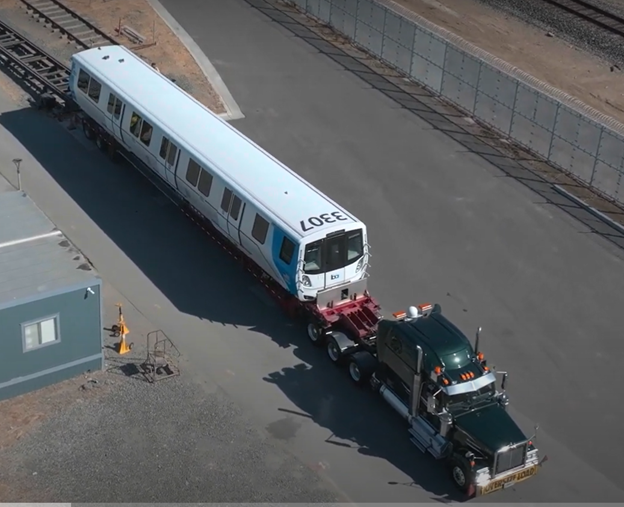
BART’s popular Fleet of the Future project has just completed one milestone, with the final car of the original contract now ready for service. The project is now entering its second phase. The last car of the original contract, car number 775, was officially certified for passenger service on Thursday, July 18th. Without missing a step, BART is now accepting cars from the second Core Capacity contract at the Hayward Test Track.
“It’s remarkable how much the new cars have changed the look and feel of BART for the better,” said BART President Bevan Dufty. “These cars are delivering on the promise of being more reliable, more modern and easier to enter and exit.”
In the six years since the first Fleet of the Future train first went into service, the new trains have gone from a surprising sight for riders to an everyday part of their trip. The legacy fleet was officially retired in April with a fond send off, but the fact is the new trains took over the system by replacing the old cars for all scheduled runs in September 2023.
The increased pace in production and delivery of the new fleet has been essential to the transition. Car manufacturer Alstom is now delivering 20 cars a month to BART, almost twice as many as the 11 cars a month stipulated in the original delivery schedule.
The quicker tempo of deliveries is one of the reasons the Fleet of the Future project is expected to come $394 million under budget. Another big cost saver was BART’s decision to have its own highly experienced staff do more of the engineering work in house. The project team, led by John Garnham, has included engineers who have successfully completed new rail car projects at other agencies.
With all 775 of the cars from the original contract now on board, BART is renewing its focus on the delivery and certification of an additional 306 rail cars for the Transbay Corridor Core Capacity Program (CCP). That’s a package of strategic investments that will allow BART to operate up to 30 ten-car trains per hour in each direction through the Transbay Tube.
An additional 48 cars, which will follow the 306 CCP cars, will serve Phase II of BART to Silicon Valley (BSVII) in the coming decades. The CCP cars and BSVII cars will bring BART’s total fleet to 1,129 rail cars.
“Getting to this transition point has been a true team effort,” said BART General Manager Bob Powers. “We’ve not only worked closely with the car maker to ensure the quality and reliability of the new cars, but we’ve created partnerships to make sure we have the funding to pay for these important investments.”
In addition to BART funds in the 775 Rail Car Project, many funding partners have made the Project possible, including:
- Federal Transit Administration (FTA)
- Metropolitan Transportation Commission (MTC)
- High Speed Rail Authority
- Strategic Growth Council/California Dept of Housing & Community Development
- California Department of Transportation (Caltrans)
- Santa Clara Valley Transportation Authority (VTA)
The Core Capacity (306) Rail Car Project is likewise supported by a coalition of funding partners, including:
- FTA
- MTC
- California State Transportation Agency (CalSTA)
- Caltrans
- San Francisco County Transportation Authority
- Alameda County Transportation Commission
The 48 BSVII rail cars are fully funded by VTA.
BART appreciates the support of all our funding partners in these regionally significant projects.
Around the Bay this Weekend: Big musical acts, a beer fest, and bike party
Friday, Oct. 13 – Last weekend, BART riders set a record for post-pandemic Saturday ridership, taking 116,200 trips. That’s 72% of our average Saturday ridership prior to the pandemic. Fantastic!
This weekend, big musical acts come to town, including P!nk on Saturday and Sunday, Oct. 14 and 15, at the Chase Center, and Maneskin on Friday, Oct. 13, at the Oakland Arena.
But the events don’t stop there. This weekend, you can ride along with the East Bay Bike Party, BART to Walnut Creek for Oktoberfest, head to Richmond for a Spirit and Soul Festival, and commune with book lovers at San Francisco’s annual literary festival Litquake. Keep reading...
Bus bridge alert: On Saturday and Sunday, Oct. 14 and 15, free buses will replace trains between Pleasant Hill and Concord stations as part of BART’s ongoing safety initiative to remove potentially hazardous trees in advance of severe winter storms. BART riders in the area should anticipate delays of up to 30 minutes on work weekends will have to disembark their train at either Pleasant Hill or Concord and then board a free bus provided by County Connection to the next station in their direction of travel to continue their trip. More info here.
For an in-depth listing of local events, visit the BARTable website. We publish a weekly event roundup, BARTable This Weekend, that highlights happenings around the region as well as cool contests and sweepstakes from our partners.
Friday, Oct. 13: East Bay Bike Party
East Bay Bike Party gets spooky on Friday with its monthly mobile party that invites riders of all ages to hit the streets and ride with each other. The theme this month is “zombie western,” so attire yourself accordingly. The group will gather at 7:30pm outside MacArthur Station for a 10 to 15-mile ride concluding at Downtown Berkeley Station with stops along the way.
Friday and Saturday, Oct. 13 and 14: Walnut Creek Obktoberfest
This weekend, Walnut Creek’s celebrates Oktoberfest in Civic Park. Enjoy a drink in the biergarten or hit the dance floor as the city recreates the beloved German fall celebration with live entertainment, gourmet food, vendors, and a Kinder Platz Kids Zone. Take BART to Walnut Creek Station and walk 0.6 miles to Civic Park.
Friday, Oct. 13, through Saturday, Oct. 21: Litquake 2023
San Francisco’s beloved literary festival Litquake is here once again! The festival hosts events across the city, culminating with a giant Lit Crawl (think bar crawl but for literature) on Saturday, Oct. 21. Check out some of the cool programs happening throughout the weekend and beyond, many of which are accessible by BART!
Saturday, Oct. 14: Richmond Spirit and Soul Festival
From 11am to 4pm on Saturday, the City of Richmond hosts a free street festival downtown that’s good for one’s mind and body. You’ll find food, workshops, arts and crafts, and short workouts, among other revitalizing activities. Take BART to Richmond Station and walk just under a mile to 190 Macdonald Avenue.
Weekend Read: BART intern Erik Huizar’s mission to increase accessibility for BART’s blind and low-vision riders
Nineteen-year-old BART intern Erik Huizar is currently working to write descriptive reports of the tactile guideways around the BART system. These guideways help blind and low-vision riders like Erik navigate BART independently.
“People rely on these trains, and not just people like me who can’t get around without them, but sighted people, too, who use them to visit friends and family or to get to work,” Erik said. “Without buses, without trains, many people wouldn’t be able to do that.”
Some of these reports have been uploaded to the BART Low Vision or Blind Accessible Services webpage and more will be added in the coming months.
Cheers to Erik!
Sweepstakes Spotlight: Win an individual membership to SFMOMA
Enter to win an individual membership to SFMOMA and unlock extraordinary access to 7 floors of awe-inspiring art, special exhibitions like "Yayoi Kusama: Infinite Love," and the first retrospective of Pacita Abad. Two winners will be selected on Monday, Oct. 16, 2023, so submit your entry before then. Find more great sweepstakes on BARTable’s Contests and Deals page.
Happy Riding this Weekend!
We hope you enjoy your weekend adventures aboard our trains.
Stay in touch by signing up for the BARTable This Weekend newsletter on the BARTable website – your one-stop shop for all things accessible by BART. You can also keep up with BARTable on Facebook and Instagram.
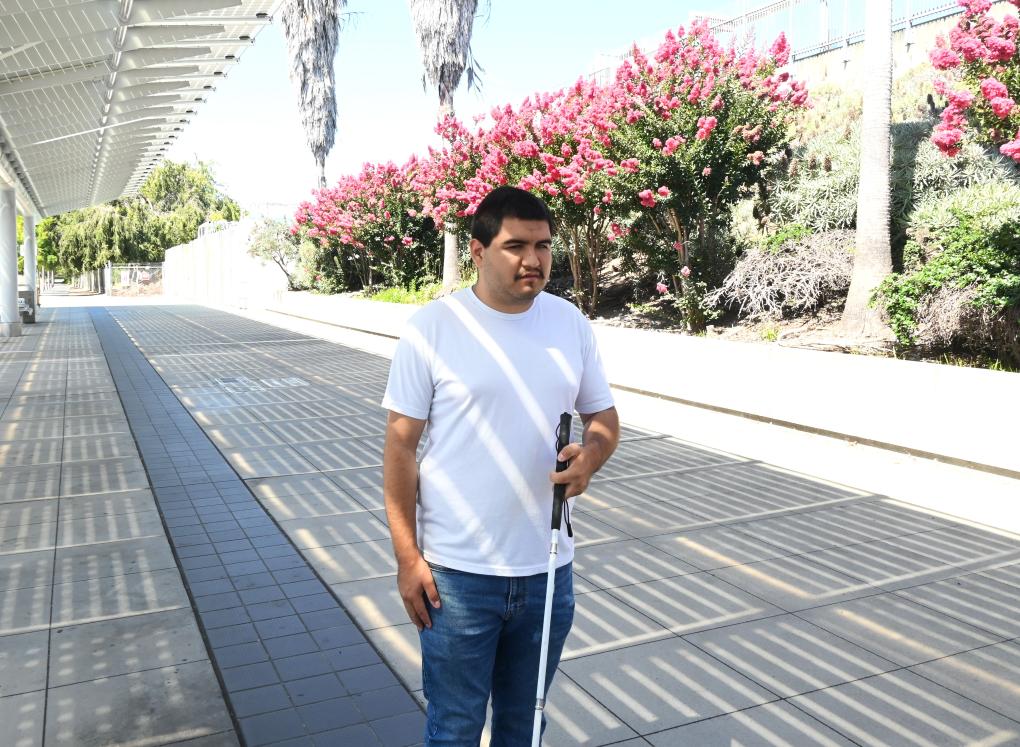
BART intern Erik Huizar poses for a portrait at Union City Station on Wednesday, Sept. 6, 2023.
Data shows continued positive trends on reliability improvements and police presence
For the second quarter in a row, BART riders are experiencing far fewer delays, train breakdowns, and cancelled trips according to the agency’s latest Quarterly Performance Report (QPR) covering July-September 2023. It is the best service delivery performance BART has had all year.
- Customer-On-Time Performance for FY 2024 Q1 (July-Sept 2023) was 92%. September specifically was 93%, the highest performing month in the last 12 months.
- The month of September had the fewest delayed trains of any month in the last five quarters.
- Cancelled trains continue to be very rare, only 1% of trains were not dispatched for the quarter.
- Total ridership was up 11% compared to the same quarter last year.
- Customer Satisfaction increased several percentage points this quarter to 74%.
“We are backing up our commitment to providing a cleaner and safer ride with concrete actions that are producing results,” said BART General Manager Bob Powers. “It’s especially encouraging that on-time performance is improving at the same time we have boosted night and weekend service to attract more riders. Cancelled trips have been nearly eliminated thanks to our success in hiring Train Operators. We will continue to work to build on these encouraging signs as we ensure BART is the safest way to travel around the Bay Area.”
BART Police Presence at Historic High
More riders than ever before say they are seeing BART’s safety presence. The percentage of riders in the survey who reported seeing BART PD on their trip the day they were questioned increased to 17%, a whopping 90% jump from the previous quarter. That exceeds BART’s official goal of 12% for the first time in history.
Sexual harassment data shows an encouraging downward trend following the launch of Phase II of the Not One More Girl campaign. The percentage of riders saying they have experience sexual harassment on BART has been declining since FY23 Q3 (Jan.-March), but it wasn’t until this quarter that the decline was statistically significant- dropping from 10% to 8%.
In addition to the findings in the Quarterly Performance Report, data shows fewer BART trains are being negatively impacted by unwanted behavior. The number of trains delayed by unwanted behavior dropped by nearly 40% from 1,144 in May to 694 in October.
The Quarterly Performance Report will be presented to the Board of Directors at the November 16th Board meeting which begins at 2pm.
Alerts and Advisories
Special late-night service added for Beyoncé Renaissance Tour on 8/30/23
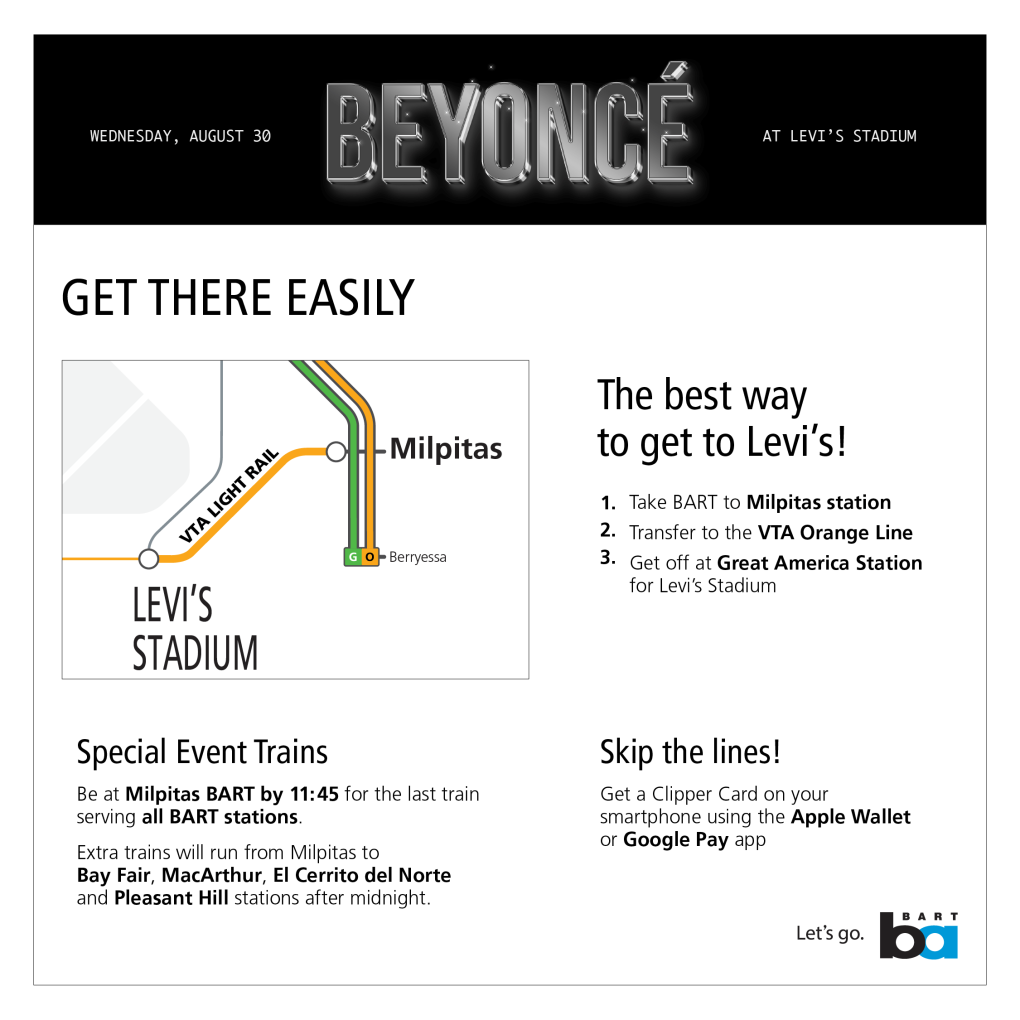
BART will run extra trains and offer special limited service after midnight for the Beyoncé Renaissance World Tour at Levi’s Stadium on Wednesday, August 30, 2023.
Getting to Levi’s Stadium using transit is easy. Fans will transfer from BART at Milpitas Station to VTA’s Orange Line and ride to VTA’s Great America Station, located on the North side of Levi’s Stadium.
BART will have extra security and station staff to help people get around.
What You Need to Know About the Ride Home
BART will run its normal last train of the evening leaving Milpitas at 11:51pm, making all regular stops. This is the last train that will get you to all BART stations in the system.
BART will run two special event service limited-stop trains that will depart Milpitas Station at around 12:30am serving limited stops after regular BART service ends.
The late-night limited service will pick up riders at Milpitas Station with stops only at the following East Bay stations, the train will skip all other stations without stopping:
- Bay Fair
- MacArthur
- Pleasant Hill
- El Cerrito del Norte
| Station | Special Event Limited Stop Trains |
| Milpitas | Departs at 12:30am and 12:35am |
| Bay Fair | Arrives at 1:06am and 1:11am |
| MacArthur | Arrives at 1:27am and 1:32am |
| El Cerrito del Norte | Arrives at 1:42am |
| Pleasant Hill | Arrives at 1:46am |
These four East Bay stations have large parking lots located near the freeway. Riders who know they want to stay until the very end of the show, should park their cars or arrange pick-up at one of these four stations. Use the timetable above to share your pick-up time.
These special limited stop trains will be labeled “Limited Stop to El Cerrito” and “Limited Stop to Pleasant Hill.”
Other Transit Options
Riders coming from San Francisco should take Caltrain home or ensure they take the 11:51pm BART train home. Caltrain is providing one extra local train from Mountain View to San Francisco 75 minutes after the show ends or when the train is full. BART is not keeping any San Francisco stations open beyond normal closing hours due to the lack of parking lots at SF stations and because Caltrain is providing this special service.
Capitol Corridor is also offering special train service that departs at 11:59pm from their Great America (GAC) station. Capitol Corridor has stops next to BART's Coliseum and Richmond stations.
Other Tips
Parking is free after 3pm at BART stations.
Before you leave home put a Clipper card on your cellphone through either Apple Pay or Google Pay. Clipper is waiving the $3 new-card fee for riders who add either of the mobile options. Please ensure you have sufficient funds for a round trip. Plan at the cost of your trip in advance.
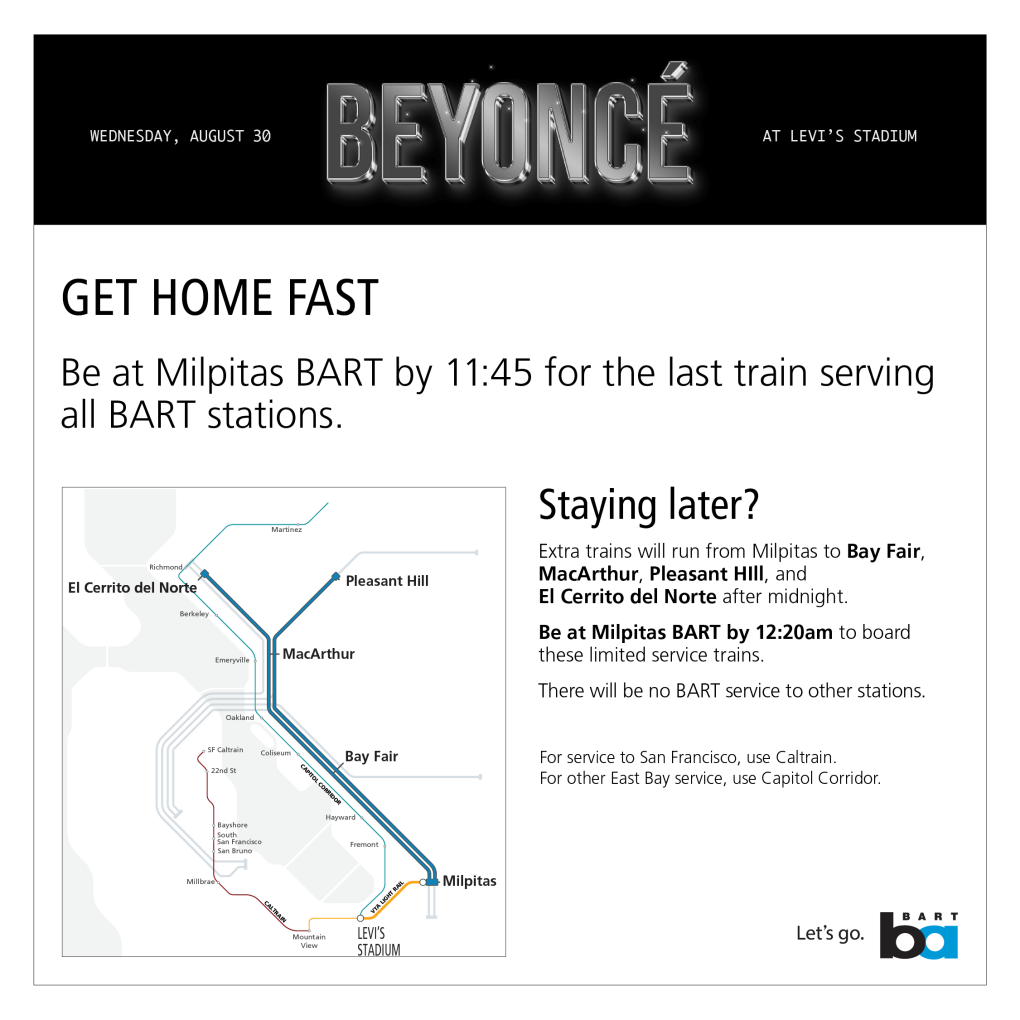
Around the Bay this Weekend: All Aboard Transit Day, special trains for A’s/Ed Sheeran, BARTable ways to observe Hispanic Heritage Month and Rosh Hashanah
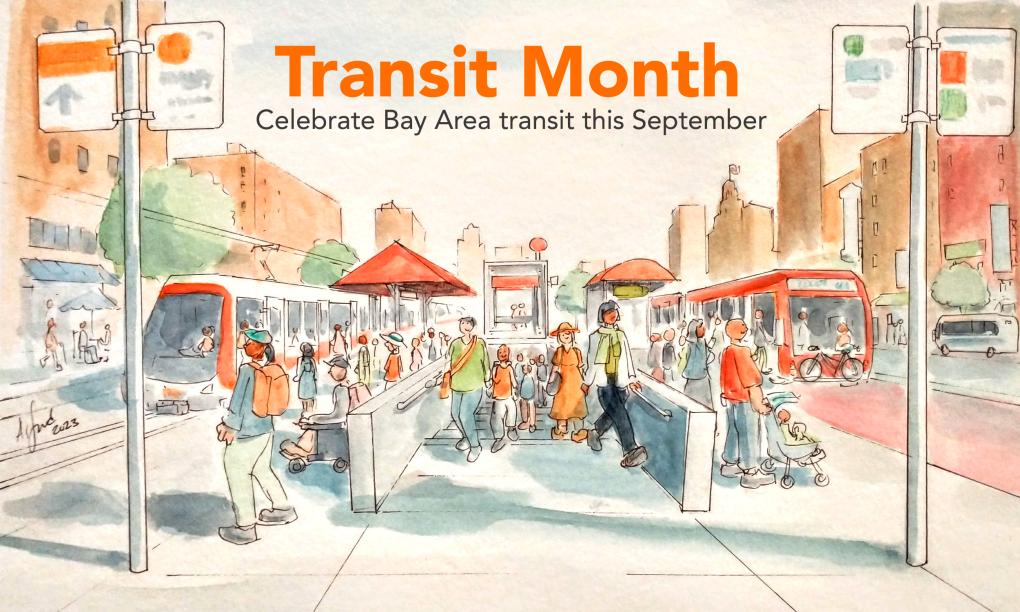
Friday, Sept. 15 – We have some huge news to share: This week we’ve seen some of the highest ridership days since the start of the pandemic. On Wednesday, we hit a major milestone – the highest ridership day since spring 2020 with 192,961 rides! Tuesday followed close behind with 192,081 rides. The numbers don’t lie – riders are coming back to BART.
If it’s been a bit since you’ve been aboard, you’ll notice some changes in our system: cleaner trains and stations, additional safety presence walking trains, and a newly reimagined schedule that increases service on weeknights and weekends. Read BART’s new Safe and Clean Plan here.
On Sunday, we greeted another milestone; we said an informal farewell to our legacy trains as our new, Fleet of the Future trains take up the helm for our base schedule (you may see some legacy trains for extra event trains and emergency contingencies). If you didn’t get to a station on Sunday to wave goodbye to the last scheduled legacy train, don’t fret! We’ll hold a proper retirement ceremony in the future, likely next year.
Speaking of celebrations, this weekend marks the start of two holidays: Hispanic Heritage Month (Sept. 15 to Oct. 15) – a celebration of the contributions, histories, and cultures of Hispanic Americans – and Rosh Hashanah (Sept. 15 to 17), the Jewish New Year and start of the High Holy Days. Read BARTable’s articles on local ways to observe the holidays here and here.
The regional celebration of public transportation – Transit Month – is still fast underway as well. To learn more about two exciting events this weekend – All Aboard Transit Day and Meet the BART Anime Mascots – keep scrolling.
We’ve also scheduled special service and event trains for two big events this weekend – the Ed Sheeran concert and the Oakland A’s vs. Padres. Find more info below.
For an in-depth listing of local events, visit the BARTable website. We publish a weekly event roundup, BARTable This Weekend, that highlights happenings around the region as well as cool contests and sweepstakes from our partners.
Saturday, Sept. 16: Special late-night service added for Ed Sheeran concert
BART will run extra trains and offer special limited service after midnight for the Ed Sheeran concert at Levi’s Stadium on Saturday, Sept. 16, 2023.
Getting to Levi’s Stadium using transit is easy. Fans will transfer from BART at Milpitas Station to VTA’s Orange Line and ride to VTA’s Great America Station, located on the north side of Levi’s Stadium.
BART will have extra security and station staff to help people get around. Learn what you need to know to get home and read our traveling tips here.

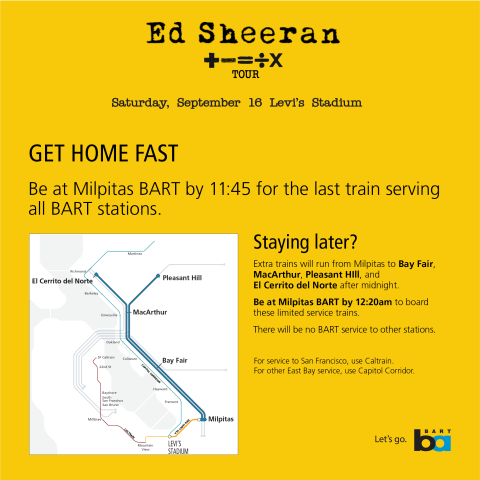
Friday, Saturday, and Sunday, Sept. 15, 16, and 17: Special event trains for Oakland Athletics vs. San Diego Padres at Oakland Coliseum
The Oakland A’s face rivals the San Diego Padres on Friday (6:40pm), Saturday (1:07pm), and Sunday (1:07pm) at the Coliseum. We’re expecting many riders to take BART, so we’ve added special event trains on Friday and Saturday to get fans home from the games.
The Friday game honors Roberto Clemente Day and will include a Latin Music Fireworks Show. The Saturday game will celebrate Latin and Hispanic Heritage Day, and Sunday will honor Make-A-Wish children and families.
Saturday, Sept. 16: All Aboard Transit Day and Meet the BART Anime Mascots at Powell Street
This Saturday, Sept. 16, is All Aboard Transit Day. On this day, we encourage people to take as many trips as their hearts desire to help us beat the September 2022 ridership record, which recorded 500,000 rides across all agencies! We'll total up the ridership numbers and report to the public if we exceed our previous record. Your rides on Saturday can be logged for the Transit Month Ride Contest, too.
Also on Saturday, Sept. 16, is our "Meet the BART Anime Mascots" event at Powell Street Station from 2pm to 6pm. Take photos with the mascots, make buttons with staff, grab a prize from the BART capsule ball machine, and more! Come in cosplay and get a rare BART anime charm. The Link21 outreach team will also table to talk about the project to build a second train crossing connecting Oakland and San Francisco.
Weekend Read: BART Board President and General Manager speak with Manny Yekutiel aboard moving train about future of Bay Area transit
On Friday, Sept. 8, around 65 people gathered in the concourse of 16th Street Mission Station to welcome their weekends aboard a BART train.
They were there to catch an evening train aboard which Manny Yekutiel, the owner of the San Francisco café Manny’s, would host a conversation with BART Board President Janice Li and General Manager Bob Powers about the future of Bay Area public transit. The gathering was a unique opportunity for BART leaders to hear directly from riders, and riders to hear from them. The ethos of the event: Why not hold such a conversation on the very trains in question?
Hear more from Manny, Li, and Powers -- as well as the riders who attended -- here.
Sweepstakes Spotlight: Win Tickets to See Manhattan Transfer at SFJAZZ
With the SFJAZZ season now upon us, enter to win tickets for you and your guest to see Manhattan Transfer on Friday, Sept. 29 at 7:30pm. The Manhattan Transfer has kept the vocalese flame burning brightly for half a century. They will bring the curtain down on a monumental career with these performances at the SFJAZZ Center on Sep 29 and 30, as part of their final tour.
Click here to enter the sweepstakes by Monday, Sept. 18.
Happy Riding this Weekend!
We hope you enjoy your weekend adventures aboard our trains.
Stay in touch by signing up for the BARTable This Weekend newsletter on the BARTable website – your one-stop shop for all things accessible by BART. You can also keep up with BARTable on Facebook and Instagram.
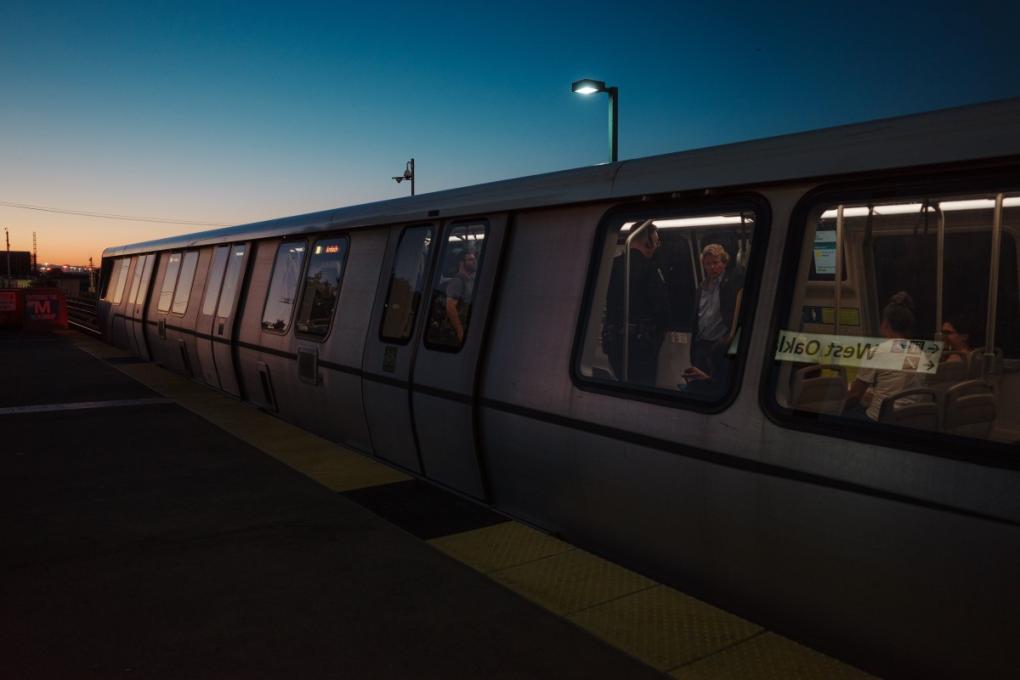
BART General Manager Bob Powers pictured through a train window at West Oakland Station as the train made its way back to the East Bay following a conversation with Manny Yekutiel, BART Board President Janice Li, and Powers on Friday, Sept. 8, 2023. Photo by Evan Dorsky.